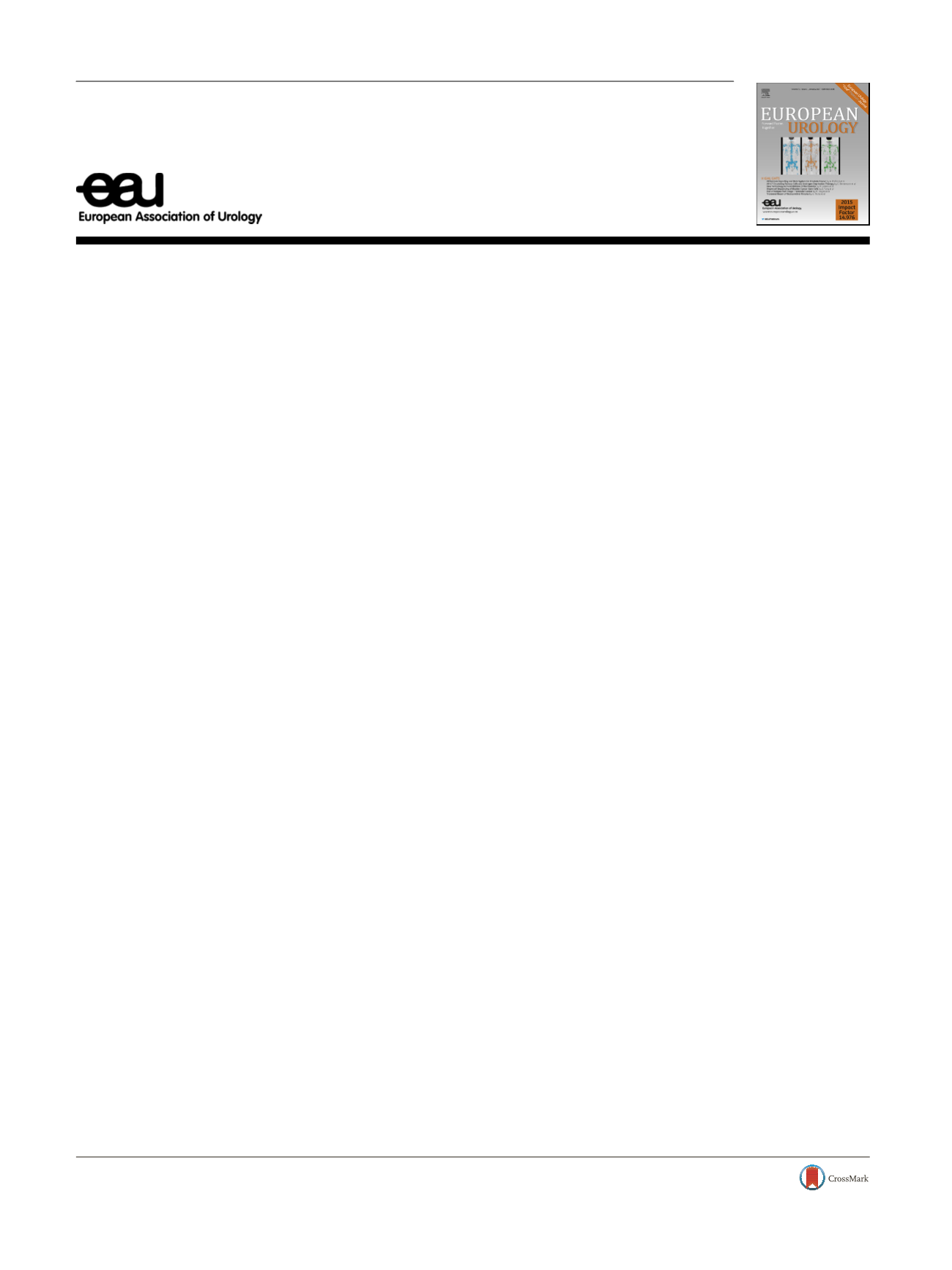

Platinum Priority – Editorial
Referring to the article published on pp. 766–773 of this issue
Local Therapy for Gleason 9–10 Prostate Cancer: Looking to the
Future
Wesley W. Ludwig, Ashley E. Ross, Philip M. Pierorazio
*The James Buchanan Brady Urological Institute and Department of Urology, Johns Hopkins University School of Medicine, Baltimore, MD, USA
The ideal management of very high-risk and locally
advanced prostate cancer continues to be a source of
debate within the medical community. Initial approaches to
treatment have traditionally entailed the use of external
beam radiation therapy (EBRT) with concurrent androgen
deprivation with or without brachytherapy (BT), or radical
prostatectomy with lymph node dissection. Recently,
clinical trials have suggested that oncologic outcomes in
such patients may be improved by the addition of docetaxel
to radiation regimens
[1,2]. In addition, reports from
ASCENDE-RT, a randomized prospective trial exploring
the combined use of EBRT and BT, suggest that addition of
BT improves oncologic control, albeit at the expense of more
local morbidity
[3] .What remains clear is that many
patients will require multimodal therapy to achieve cure or
a durable response
[4] .While the number of options is
robust, evidence of clinical superiority for a particular
modality is lacking. There are no reported randomized
prospective trials comparing surgery and radiation-based
approaches in this setting. In the absence of such a trial,
scientific advances such as genomic and predictive bio-
markers, as well as novel imaging modalities for improved
diagnostic staging, may augment individualized decision-
making for patients with very high-risk disease
[5,6].
The article by Kishan et al
[7]in this issue of
European
Urology
explores the outcomes for men with Gleason 9–10
prostate cancer treated with EBRT, extremely dose-escalat-
ed radiotherapy (EBRT + BT), or radical prostatectomy (RP).
The comparative effectiveness of the relative treatments is
hypothesis-generating at best and is limited by the
retrospective study design, lack of propensity matching,
and lack of uniform treatment. However, important points
can be gleaned and are highlighted by the authors. First, the
results support the findings of the ASCENDE-RT trial, with
the best cancer-specific outcomes observed among men
who had BT combined with EBRT
[3]. This supports a
discussion of BT boost for men with high-grade disease, as
this may be a superior choice for men with limited baseline
urinary symptoms and favorable anatomy. Second, men
electing to undergo primary surgical therapy should be
counseled that the majority will require multimodal
therapy for local control. It is important to recognize the
evolution of surgery and adjuvant or salvage treatments, as
this evolution is not specifically addressed in the manu-
script. An improved understanding of the importance of
lymphadenectomy suggests that extended lymph-node
dissections be performed in patients with very high risk
[8] .This practice will hopefully be facilitated by the
increasing aptitude of high-volume robotic surgeons.
Given the aggressive nature of Gleason 9–10 prostate
cancer, close follow-up is mandatory and there should be a
very low threshold for adjuvant and salvage RT after
surgery. When RT is applied in this setting, it should be done
so with the recognition that the disease may be local-
regional. In this regard, adjuvant or salvage RT should be
applied to the pelvis and not the prostate bed alone, as
shown in RTOG 9601, and should be applied concurrent
with hormonal deprivation
[9] .Finally, while neoadjuvant
hormonal therapy has not shown oncologic benefit before
surgery in previous trials, it has not been thoroughly
investigated. The high-risk population is more likely to have
micrometastatic disease, and this issue has only begun to be
explored with the use of newer androgen-axis inhibitors
[10] . E U R O P E A N U R O L O G Y 7 1 ( 2 0 1 7 ) 7 7 4 – 7 7 5available at
www.scienced irect.comjournal homepage:
www.europeanurology.comDOI of original article:
http://dx.doi.org/10.1016/j.eururo.2016.06.046.
* Corresponding author. The James Buchanan Brady Urological Institute, 600 North Wolfe Street, Baltimore, MD 21287, USA. Tel. +1 410 5025984;
Fax: +1 410 5027711.
E-mail address:
philpierorazio@jhmi.edu(P.M. Pierorazio).
http://dx.doi.org/10.1016/j.eururo.2016.07.0250302-2838/
#
2016 European Association of Urology. Published by Elsevier B.V. All rights reserved.
















